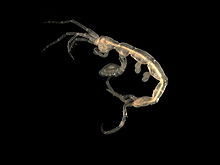
Amphipoda is an order of malacostracan crustaceans with no carapace and generally with laterally compressed bodies. Amphipods range in size from 1 to 340 millimetres and are mostly detritivores or scavengers. There are more than 9,900 amphipod species so far described. They are mostly marine animals, but are found in almost all aquatic environments. Some 1,900 species live in fresh water, and the order also includes the terrestrial sandhoppers such as Talitrus saltator and Arcitalitrus sylvaticus.

The superorder Peracarida is a large group of malacostracan crustaceans, having members in marine, freshwater, and terrestrial habitats. They are chiefly defined by the presence of a brood pouch, or marsupium, formed from thin flattened plates (oostegites) borne on the basalmost segments of the legs. Peracarida is one of the largest crustacean taxa and includes about 12,000 species. Most members are less than 2 cm (0.8 in) in length, but the largest is probably the giant isopod which can reach 76 cm (30 in). The earliest known perecaridian was Oxyuropoda ligioides, a fossil of which has been found dating to the Late Devonian of Ireland.

The Reverend Thomas Roscoe Rede Stebbing was a British zoologist, who described himself as "a serf to natural history, principally employed about Crustacea". Educated in London and Oxford, he only took to natural history in his thirties, having worked as a teacher until then. Although an ordained Anglican priest, Stebbing promoted Darwinism in a number of popular works, and was banned from preaching as a result. His scientific works mostly concerned crustaceans, especially the Amphipoda and Isopoda, the most notable being his work on the amphipods of the Challenger expedition.
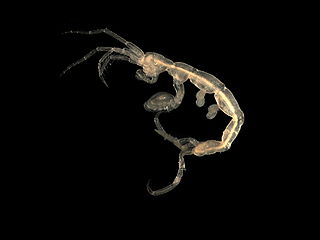
Caprellidira is a parvorder of marine crustaceans of the infraorder Corophiida. The group includes skeleton shrimps (Caprellidae) and whale lice (Cyamidae).

Caprellidae is a family of amphipods commonly known as skeleton shrimps. Their common name denotes the threadlike slender body which allows them to virtually disappear among the fine filaments of seaweed, hydroids and bryozoans. They are sometimes also known as ghost shrimps.

Cumacea is an order of small marine crustaceans of the superorder Peracarida, occasionally called hooded shrimp or comma shrimp. Their unique appearance and uniform body plan makes them easy to distinguish from other crustaceans. They live in soft-bottoms such as mud and sand, mostly in the marine environment. There are more than 1,500 species of cumaceans formally described. The species diversity of Cumacea increases with depth.

Phronima sedentaria is a species of amphipod crustaceans found in oceans at a depth of up to 1 km (0.6 mi). They are large in size relative to other members of the family Phronimidae. Individuals may be found inside barrel-like homes, created most commonly from the tunics of select species of tunicate, where they rear their young. P. sedentaria is known to employ multiple feeding strategies and other interesting behaviors, including daily vertical migration. The species is also known by the more common names “pram bug” and “barrel shrimp.”
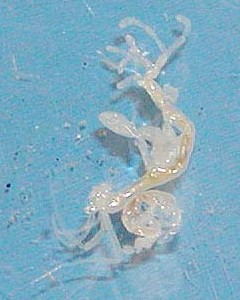
Caprella bathytatos is a species of skeleton shrimp in the genus Caprella. It was described in 1998 by Joel W. Martin and Gary Pettit, who discovered it living on the mouthparts of the crab Macroregonia macrochira near hydrothermal vents in British Columbia.
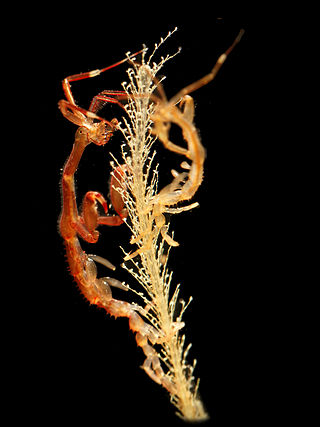
Caprella mutica, commonly known as the Japanese skeleton shrimp, is a species of skeleton shrimp. They are relatively large caprellids, reaching a maximum length of 50 mm (2.0 in). They are sexually dimorphic, with the males usually being much larger than the females. They are characterized by their "hairy" first and second thoracic segments and the rows of spines on their bodies. Body color ranges from green to red to blue, depending on the environment. They are omnivorous highly adaptable opportunistic feeders. In turn, they provide a valuable food source for fish, crabs, and other larger predators. They are usually found in dense colonies attached to submerged man-made structures, floating seaweed, and other organisms.

Caprelloidea is a superfamily of marine crustaceans in the order Amphipoda. It includes "untypical" forms of amphipods, such as the skeleton shrimps (Caprellidae) and whale lice (Cyamidae). The group was formerly treated as one of the four amphipod suborders, Caprellidea, but has been moved down to the superfamily rank by Myers & Lowry after phylogenetic studies of the group, and is now contained in the infraorder Corophiida of the suborder Senticaudata. The group includes the following families.

Caprella linearis is a species of skeleton shrimp in the genus Caprella. It is native to the North Atlantic, North Pacific, and the Arctic Ocean. It closely resembles Caprella septentrionalis with which it shares the same geographical distribution.

Geryon trispinosus is a species of crab that lives in deep water in the north-eastern Atlantic Ocean.
Sunamphitoe femorata is a species of amphipod crustacean in the family Ampithoidae. It is a herbivore and constructs a tubular nest-like home on a blade of the sporophyte of the giant kelp Macrocystis pyrifera. This home is made by rolling the sides of the blade together and securing them with silk. As the kelp blade grows, the nest is advanced down the blade towards the base, approximately keeping pace with the algal growth.
Caprellinoides is a genus of amphipods in the family Caprellidae.
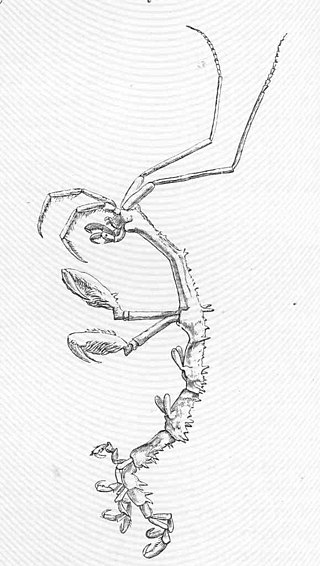
Aeginina is a genus of amphipods in the family Caprellidae. There are at least 2 described species in Aeginina.

Caprella equilibra is a species of skeleton shrimp in the family Caprellidae. It lives among other organisms on the seabed and occurs in both shallow and deep water in many parts of the world.

Ampithoidae is a family of amphipod crustaceans. The family has a worldwide distribution as algal dwellers. They commonly create tube-shaped nests on their host plants or algae which serve as both shelter and food. Young ampithoids develop from eggs to a larval stage within their mother's brood-pouch, formed by the appendages of her abdomen.

Caprella unica is a species of skeleton shrimp in the genus Caprella within the family Caprellidae. The larvae are plankton-like. They are relatively small, with two large and two small antennae. They only live in the sea, and are widely found in Cape Cod, Maine and Newfoundland.

Eurythenes is a genus of marine amphipods in the family Eurytheneidae.
Eurythenes thurstoni is a species of amphipod of the genus Eurythenes. It was first described in 2004 and named after Mike Thurston, a marine biologist specialising in deep-sea amphipods.
